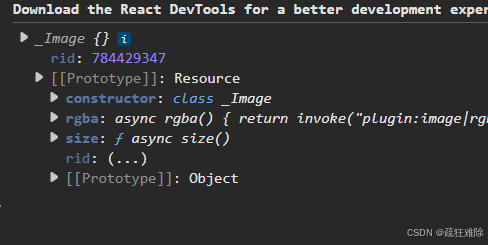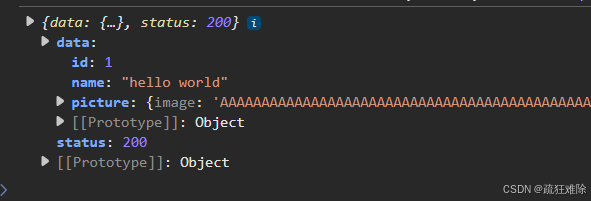【Tauri2】047——Image
目录
前言
正文
看看注册的通信函数
看看new方法
看看rgba
使用一下resources_table
返回User
间接返回Image
总结
前言
前面clipboard插件的时候,使用了Image这个结构体,但是这个东西也类似于window一样,是一个内置的插件。
【Tauri2】046—— tauri_plugin_clipboard_manager(一)-CSDN博客![]() https://blog.csdn.net/qq_63401240/article/details/148077505?spm=1001.2014.3001.5501
https://blog.csdn.net/qq_63401240/article/details/148077505?spm=1001.2014.3001.5501
Image结构体的定义
#[derive(Debug, Clone)]
pub struct Image<'a> {rgba: Cow<'a, [u8]>,width: u32,height: u32,
}插件源码参考如下
tauri/crates/tauri/src/image at dev · tauri-apps/tauri![]() https://github.com/tauri-apps/tauri/tree/dev/crates/tauri/src/image
https://github.com/tauri-apps/tauri/tree/dev/crates/tauri/src/image
正文
看看注册的通信函数
/// Initializes the plugin.
pub fn init<R: Runtime>() -> TauriPlugin<R> {Builder::new("image").invoke_handler(crate::generate_handler![#![plugin(image)]new, from_bytes, from_path, rgba, size]).build()
}有四个方法。
意思是很明显的,
看看new方法
#[command(root = "crate")]
fn new<R: Runtime>(webview: Webview<R>,rgba: Vec<u8>,width: u32,height: u32,
) -> crate::Result<ResourceId> {let image = Image::new_owned(rgba, width, height);let mut resources_table = webview.resources_table();let rid = resources_table.add(image);Ok(rid)
}需要传入3个参数。
获取了resources_table ,这是什么?
跟着源码往里面走。
pub(crate) resources_table: Arc<Mutex<ResourceTable>>,#[derive(Default)]
pub struct ResourceTable {index: BTreeMap<ResourceId, Arc<dyn Resource>>,
}可以发现本质是BTreeMap——平衡多路搜索树,基于 B树(B-Tree) 实现的键值对集合类型
意思就是初始化了一个Image,放到树里面。
let rid = resources_table.add(image);调用add方法会返回键rid——ResourceId
pub fn add<T: Resource>(&mut self, resource: T) -> ResourceId 把rid传回去。看来是这么初始化的。
那么from_bytes,和from_path,应该是差不多的,一个传字节数组,一个传路径,初始化,然后放到BtreeMap中。
使用
async function clicked() {const image =await Image.fromPath("./icons/icon.png");console.log(image);}
会返回rid。
看看rgba
#[command(root = "crate")]
fn rgba<R: Runtime>(webview: Webview<R>, rid: ResourceId) -> crate::Result<Vec<u8>> {let resources_table = webview.resources_table();let image = resources_table.get::<Image<'_>>(rid)?;Ok(image.rgba().to_vec())
}需要传一个rid进来,然后获取rid这个键所对应的值。返回。
获取rgba,很简单
async function clicked() {let res=await invoke("plugin:image|rgba",{"rid":784429347})console.log(res);}结果如下

没问题。
这个插件很简单。
使用一下resources_table
不妨模仿一下,自定义通信函数,使用这个resources_table
先使用add方法,然后使用get
再先看看add
pub fn add<T: Resource>(&mut self, resource: T) -> ResourceId {self.add_arc(Arc::new(resource))}可以发现一个关键的东西,泛型T的泛型约束是Resource
意思是自定义了一个结构体,需要实现这个trait,才可以。
不妨自定义一个结构体叫User,不知道取什么名字,随便吧。
看看Image是怎么搞的
impl Resource for Image<'static> {}什么都不用实现
就这样???好。
因此,代码如下
use tauri::{Manager, Resource, ResourceId, Webview, command};
struct User {id: i32,name: String,
}
impl Resource for User {}#[command]
fn greet(webview: Webview, id: i32) -> ResourceId {let mut table = webview.resources_table();let user = User {id,name: "hello world".to_string(),};let a = table.add(user);a
}注册通信函数。触发

可以发现返回了这个所谓的rid。没问题。
获取user
#[command]
fn get_user(webview: Webview, id: ResourceId) -> String {let table = webview.resources_table();let user = table.get::<User>(id).unwrap();format!("id: {}, name: {}", user.id, user.name)
}没有返回User,暂时返回一个String,
结果如下

没问题。
返回User
即,希望如下代码运行
#[command]
fn get_user(webview: Webview, id: ResourceId) -> User {let table = webview.resources_table();let user = table.get::<User>(id).unwrap();User {id: user.id,name: user.name.clone(),}
}实际上,编译会报错
error[E0599]: the method `blocking_kind` exists for reference `&User`, but its trait bounds were not satisfied--> src\main.rs:20:1|
4 | struct User {| ----------- doesn't satisfy `User: IpcResponse`note: the trait `IpcResponse` must be implemented--> C:\Users\26644\.cargo\registry\src\index.crates.io-1949cf8c6b5b557f\tauri-2.5.1\src\ipc\mod.rs:171:1|
171 | pub trait IpcResponse {| ^^^^^^^^^^^^^^^^^^^^^= help: items from traits can only be used if the trait is implemented and in scope= note: the following traits define an item `blocking_kind`, perhaps you need to implement one of them:candidate #1: `tauri::ipc::private::ResponseKind`candidate #2: `tauri::ipc::private::ResultKind`= note: this error originates in the macro `__cmd__get_user` which comes from the expansion of the macro `tauri::generate_handler` (in Nightly builds, run with -Z macro-backtrace for more info)一言以蔽之,需要为User实现IpcResponse这个trait。可以自己实现
但是,如下代码
pub trait IpcResponse {/// Resolve the IPC response body.fn body(self) -> crate::Result<InvokeResponseBody>;
}impl<T: Serialize> IpcResponse for T {fn body(self) -> crate::Result<InvokeResponseBody> {serde_json::to_string(&self).map(Into::into).map_err(Into::into)}
}从上面代码中可以知道,只需要实现Serialize这个triat,因为实现了Serialize这个trait,就实现IpcResponse 这个trait。
因此,代码如下
#[derive(Serialize)]
struct User {id: i32,name: String,
}初始化并查询
async function clicked() {let rid=await invoke("greet",{"id":1})let res = await invoke("get_user", {"id": rid});console.log(res);}结果如下

当然,也可以自定义IpcResponse这个trait,
实现IpcResponse,需要实现body方法
但是,同时考虑
#[derive(Debug, Clone)]
#[cfg_attr(test, derive(PartialEq))]
pub enum InvokeResponseBody {/// Json payload.Json(String),/// Bytes payload.Raw(Vec<u8>),
}只能使用Json和Raw
因此,代码如下
use tauri::ipc::{InvokeResponseBody, IpcResponse};
use serde_json::json;
impl IpcResponse for User {fn body(self) -> tauri::Result<InvokeResponseBody> {let value = json!({"status": 200,"data": {"id": self.id,"name": self.name}});Ok(InvokeResponseBody::Json(value.to_string().into()))}
}如果不是Json,运行可能报错
VM9:111 IPC custom protocol failed, Tauri will now use the postMessage interface instead SyntaxError: Unexpected token 'u', "user id=1 "... is not valid JSON
结果如下

当然,没必要这么麻烦,实现序列化就可以了。没什么区别。
间接返回Image
前面提到通信函数中返回Image也会遇到没有实现IpcResponse这个trait的问题
而不能直接为Imgae实现IpcResponse这个trait,会触发孤儿规则,因此使用新的类型,包装Image。
比如
struct NewImage(Image<'static>);然后在前面User中使用Image,即
struct User {id: i32,name: String,picture: NewImage,
}后面就是自定义序列化,因此,最后全部的代码如下
#![cfg_attr(not(debug_assertions), windows_subsystem = "windows")]
use base64::{Engine, engine::general_purpose};
use serde_json::json;
use tauri::image::Image;
use tauri::ipc::{InvokeResponseBody, IpcResponse};
use tauri::{Manager, Resource, ResourceId, Result, Webview, command};#[derive(Clone)]
struct NewImage(Image<'static>);impl NewImage {fn to_json_value(&self) -> serde_json::Value {let base64_str = general_purpose::STANDARD.encode(self.0.rgba());json!({ "image": base64_str })}
}struct User {id: i32,name: String,picture: NewImage,
}impl Resource for User {}
impl IpcResponse for User {fn body(self) -> Result<InvokeResponseBody> {let value = json!({"status": 200,"data": {"id": self.id,"name": self.name,"picture": self.picture.to_json_value()}});Ok(InvokeResponseBody::Json(value.to_string().into()))}
}#[command]
fn greet(webview: Webview, id: i32) -> ResourceId {let mut table = webview.resources_table();let user = User {id,name: "hello world".to_string(),picture: NewImage(Image::from_path("./icons/icon.png").unwrap()),};table.add(user)
}
#[command]
fn get_user(webview: Webview, id: ResourceId) -> User {let table = webview.resources_table();let user = table.get::<User>(id).unwrap();User {id: user.id,name: user.name.clone(),picture: user.picture.clone(),}
}
fn main() {tauri::Builder::default().invoke_handler(tauri::generate_handler![greet, get_user]).run(tauri::generate_context!()).expect("error while running tauri application");
}
笔者把rgba数据变成base64字符串。方便序列化。
base64 = { version = "0.22.1", features = ["default"] }添加克隆,结果如下。

或者为User实现自定义序列化
use serde::ser::SerializeMap;
impl Serialize for User {fn serialize<S>(&self, serializer: S) -> std::result::Result<S::Ok, S::Error>whereS: Serializer,{let mut map = serializer.serialize_map(Some(3))?;map.serialize_entry("id", &self.id)?;map.serialize_entry("name", &self.name)?;map.serialize_entry("picture", &self.picture.to_json_value())?;map.end()}
}结果如下

无论是实现IpcResponse这个trait还是实现Serialize ,都行。
总结
看了看Image这个插件。
